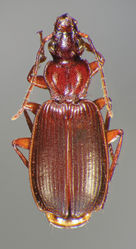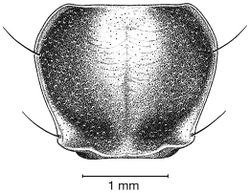Cymindis punctigera sulcipennis
| Notice: | This page is derived from the original publication listed below, whose author(s) should always be credited. Further contributors may edit and improve the content of this page and, consequently, need to be credited as well (see page history). Any assessment of factual correctness requires a careful review of the original article as well as of subsequent contributions.
If you are uncertain whether your planned contribution is correct or not, we suggest that you use the associated discussion page instead of editing the page directly. This page should be cited as follows (rationale):
Citation formats to copy and paste
BibTeX: @article{Hunting2013ZooKeys259, RIS/ Endnote: TY - JOUR Wikipedia/ Citizendium: <ref name="Hunting2013ZooKeys259">{{Citation See also the citation download page at the journal. |
Ordo: Coleoptera
Familia: Carabidae
Genus: Cymindis
Name
Cymindis punctigera (Horn) stat. n. – Wikispecies link – Pensoft Profile
- Pinacodera sulcipennis Horn 1881[1]: 40. HOLOTYPE male, labeled: “Cal”; [small yellow paper rectangle]; “HOLOTYPE 2932” [red paper]; “Pinacodera sulcipennis” Horn [handwritten]. [MCZC]. – Horn 1882[2]: 147–148. – 1894: 310. TYPE AREA – Baja California, Mexico syn. n.
- Pinacodera semisulcata Horn 1881[1]: 40. HOLOTYPE, male labeled: “Cal”; [small yellow paper rectangle]; “Pinacodera semisulcata” Horn [handwritten]. [MCZC]. TYPE AREA - Baja California Sur – Horn 1882[2]: 147–149. – 1894: 310. syn. n.
Type locality
La Paz, Baja California Sur, Mexico, here designated.
Notes about synonymy
Horn (1881:40) distinguished Pinacodera sulcipennis from Pinacodera semisulcata through the former having raised elytral intervals. Careful examination of more than 80 specimens revealed that some members of this subspecies (32%) have raised elytral intervals, especially in the basal third. This is the rationale for combining Pinacodera semisulcata with Pinacodera sulcipennis.
Diagnosis
Most specimens of this subspecies (94.2%) have two to several rugulose transverse lines on dorsal surface of head between eyes with rugosity in some extended to clypeus (Fig. 25B).
Description
With character states of subgenus Pinacodera and species Cymindis punctigera restricted as follows: OBL 8.26 – 10.67 mm. Length (n= 20 males, 20 females): head 0.80 – 1.02, pronotum 1.72 – 2.20 , elytra 4.50 – 6.12, metepisternum 0.94 – 1.48 mm; width: head 1.72 – 2.20 , pronotum 2.00 – 2.64, elytra 3.12– 4.33, metepisternum 0.45 – 0.86 mm.
Body proportions. HW/HL 1.91 – 2.30; PWM/PL 1.08 – 1.25; EL/EW 1.26 – 1.49; ML/MW 1.40 – 1.88.
Color (Fig. 23). Dorsum of head rufous to rufo-piceous; dorsum of pronotum and elytra rufous to rufo-piceous; antennae rufo- testaceous to rufo- piceous; palpi rufo-testaceous to rufo-piceous; elytral epipleura rufo-testaceous to rufo-piceous; abdominal sterna and other thoracic sclerites rufo-testaceous to rufo-piceous.
Elytra (Fig. 23). Humeri narrowed. Hind wings. Brachypterous.
Male Genitalia Phallus (cf. Fig. 24A-C) length 1.82–2.00 mm.
Collection notes and habitat
The known elevational range of Cymindis punctigera sulcipennis extends from 140 to 1850 m. Specimens have been collected from stands of yucca and on shrubs of the species Euphorbia misera Benth.
Geographical distribution
This subspecies is restricted to Baja California in Mexico (Fig. 29), ranging from the southern tip of the peninsula, to as far north as San Quentin, Baja California Norte.
Morphological affinities
This subspecies is by definition the closest relative of Cymindis punctigera punctigera.
Chorological affinities
Cymindis punctigera sulcipennis is allopatric with Cymindis punctigera punctigera and with all other taxa of the limbata group.
Material examined
I have examined 84 specimens; 10 males and 10 females were dissected. For details see University of Alberta Strickland Virtual Entomology Museum Database (University of Alberta 2009[3]).
Taxon Treatment
- Hunting, W; 2013: A taxonomic revision of the Cymindis (Pinacodera) limbata species group (Coleoptera, Carabidae, Lebiini), including description of a new species from Florida, U.S.A. ZooKeys, 259: 1-73. doi
Other References
- ↑ 1.0 1.1 Horn G (1881) On the genera of Carabidae with special reference to the fauna of boreal America. Transactions of the American Entomological Society 9: 91–196, illus.
- ↑ 2.0 2.1 Horn G (1882) Synopsis of the species of the tribe Lebiini. Tranactions of the American Entomological Society 10: 126–164, illus.
- ↑ University of Alberta (2009) E. H. Strickland Virtual Entomology museum Database. Retrieved August 25, 2009, Web site: http://www.entomology.museums.ualberta.ca/
Images
|



